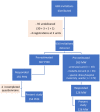Midwives and public health nurses' knowledge and clinical practice in securing sufficient iodine status in relation to pregnancy: A cross-sectional study
- PMID: 36840923
- PMCID: PMC10277439
- DOI: 10.1002/nop2.1675
Midwives and public health nurses' knowledge and clinical practice in securing sufficient iodine status in relation to pregnancy: A cross-sectional study
Abstract
Aim: To investigate midwives' (MWs) and public health nurses' (PHNs) clinical practice and knowledge related to nutrition, with a particular focus on iodine in northern parts of Norway. Maternal iodine status prior to and during pregnancy, and the lactating period, is crucial for brain development and growth of the foetus and infant, from conception up until the first two years of life. In Norway, studies have documented mild to moderate iodine deficiency in this group.
Design/methods: MWs (n = 128) and PHNs (n = 154) responded to a survey regarding nutrition and iodine. Descriptive data and non-parametric tests were used to analyse data.
Results: Around half of the participants provided dietary guidance to a great extent. Practice of iodine-specific recommendations was lower, particularly regarding lactating women. Compared to other nutrients, iodine was not a priority.
Conclusion: The study indicates a lack of knowledge and poor clinical practice about iodine among MWs and PHNs.
Keywords: dietary; infant; iodine; lactation; maternal health; midwifery; nutrition; pregnancy; public health nurses.
© 2023 The Authors. Nursing Open published by John Wiley & Sons Ltd.
Conflict of interest statement
No conflict of interest.
Figures



Similar articles
-
A balancing act-midwives' and public health nurses' experiences with breastfeeding counselling.Scand J Caring Sci. 2024 Mar;38(1):92-103. doi: 10.1111/scs.13198. Epub 2023 Jul 26. Scand J Caring Sci. 2024. PMID: 37496198
-
Research utilisation in clinical practice: the experience of nurses and midwives working in public hospitals.Reprod Health. 2021 Mar 15;18(1):62. doi: 10.1186/s12978-021-01095-x. Reprod Health. 2021. PMID: 33722262 Free PMC article.
-
Iodine Supplementation in Women During Preconception, Pregnancy, and Lactation: Current Clinical Practice by U.S. Obstetricians and Midwives.Thyroid. 2017 Mar;27(3):434-439. doi: 10.1089/thy.2016.0227. Epub 2016 Dec 22. Thyroid. 2017. PMID: 27784201
-
Breastfeeding and maternal and infant iodine nutrition.Clin Endocrinol (Oxf). 2009 May;70(5):803-9. doi: 10.1111/j.1365-2265.2008.03442.x. Epub 2008 Oct 6. Clin Endocrinol (Oxf). 2009. PMID: 19178515 Review.
-
A meta-ethnographic synthesis of midwives' and nurses' experiences of adverse labour and birth events.J Clin Nurs. 2017 Dec;26(23-24):4184-4200. doi: 10.1111/jocn.13965. Epub 2017 Sep 19. J Clin Nurs. 2017. PMID: 28722761 Review.
References
-
- Andersson, M. , de Benoist, B. , Delange, F. , & Zupan, J. (2007). Prevention and control of iodine deficiency in pregnant and lactating women and in children less than 2‐years‐old: Conclusions and recommendations of the Technical Consultation. Public Health Nutrition, 10(12A), 1606–1611. 10.1017/S1368980007361004 - DOI - PubMed
Publication types
MeSH terms
Substances
LinkOut - more resources
Full Text Sources

